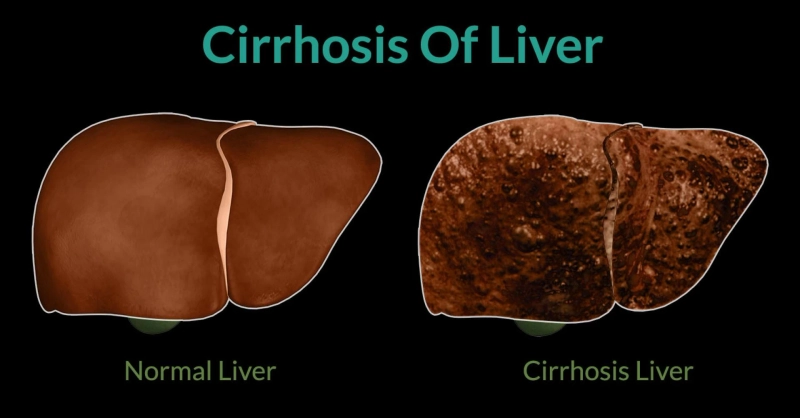Cirrhosis Disease Overview:
Cirrhosis Disease is a progressive and irreversible liver condition characterized by the replacement of healthy liver tissue with scar tissue. This scarring disrupts the liver's normal structure and function, leading to significant health complications. Cirrhosis often develops as a result of chronic liver diseases such as hepatitis, long-term alcohol consumption, or non-alcoholic fatty liver disease.
In order to encourage early detection and intervention, cirrhosis awareness must be raised. In order to effectively treat cirrhosis, which is characterized by scarring of the liver tissue, a prompt diagnosis is essential. Improved awareness promotes routine screenings, particularly for those who are more vulnerable, and helps identify signs. Professionals in the medical field might potentially avert problems and slow down the progression of disease by using early diagnosis to drive effective interventions. Furthermore, a key component of preventing and treating cirrhosis is highlighting the need of lifestyle changes like quitting alcohol and maintaining a healthy diet. Raising awareness helps people make liver health a priority, get help when they need it, and ultimately combat cirrhosis with better results.
The Market Competitors Listed Below are Revolutionizing Healthcare with Innovative Diagnostic & Treatment Inventions:
Diagnostic Market Players:
Hipro BiotechnologyAtlasHisky Medical TechnologiesZecen Biotech Co., LtdFujirebioMelrose BiotechnologyGP Getein Biotech,Inc.OthersTreatment Market Players:
AbbVieCurewell Drugs and Pharmaceuticals Pvt LtdZydus CadilaAbbottSun PharmaceuticalZeelab Pharmacy Pvt LtdRPG Life Sciences LtdOthersSymptoms:
The symptoms of cirrhosis may not manifest until the disease has progressed significantly. Common symptoms include fatigue, weakness, easy bruising, swelling in the legs and abdomen, loss of appetite, and jaundice (yellowing of the skin and eyes). As the liver function declines, complications such as portal hypertension and hepatic encephalopathy can arise.
Diagnostic Analysis:
Diagnosing cirrhosis involves a combination of medical history assessment, physical examinations, and various diagnostic tests. Blood tests measuring liver function, imaging studies like CT scans or MRIs, and liver biopsy may be utilized to confirm the presence and severity of cirrhosis.
Get a Free Sample Research Report:
https://www.diseaselandscape.com/downloadsample/postid/148
Treatment Analysis:
While there is no cure for cirrhosis, the focus of treatment is on managing symptoms, preventing complications, and addressing the underlying cause. Lifestyle changes, such as alcohol cessation and a healthy diet, are crucial. Medications may be prescribed to manage symptoms and address specific complications, and in some cases, liver transplantation may be recommended for advanced cirrhosis.
Regulatory Framework:
The regulatory landscape for cirrhosis treatment involves rigorous scrutiny by health authorities to ensure the safety and efficacy of new treatments. Regulatory agencies play a pivotal role in approving drugs and therapies, ensuring they meet stringent standards before entering the market.
Clinical Assessment:
Clinical trials are essential for advancing our understanding of cirrhosis and developing new treatment options. These trials involve carefully monitored testing of new drugs and therapies on human subjects to determine their safety and efficacy. Rigorous clinical assessment is crucial to bringing innovative treatments to the forefront.
Drug Development:
The development of drugs for cirrhosis involves extensive research and testing. Pharmaceutical companies invest significant resources in identifying potential therapeutic targets and developing drugs that can modify the course of the disease. This process requires collaboration between researchers, clinicians, and regulatory bodies to navigate the complex path from discovery to approval.
Get Full Insights:
https://www.diseaselandscape.com/chronic/cirrhosis
Market Trends Analysis:
Market trends in cirrhosis treatment are shaped by advancements in research, emerging therapies, and the evolving needs of patients. The market for cirrhosis treatment is dynamic, with a focus on improving patient outcomes and quality of life. This includes the development of targeted therapies and innovative approaches to address the diverse causes and stages of cirrhosis.
Regional Insights:
The prevalence of cirrhosis varies across regions, influenced by factors such as lifestyle, healthcare infrastructure, and the prevalence of underlying liver diseases. Understanding regional insights is crucial for tailoring treatment strategies, implementing public health initiatives, and ensuring equitable access to care.
Conclusion:
Cirrhosis remains a significant public health concern, impacting millions of individuals worldwide. Advances in diagnostic tools, treatment options, and ongoing research offer hope for improved outcomes. Collaborative efforts between healthcare professionals, researchers, and regulatory bodies are essential to addressing the multifaceted challenges posed by cirrhosis and enhancing the quality of life for affected individuals. Continued investment in research, development, and healthcare infrastructure will play a pivotal role in the future landscape of cirrhosis management.
Browse Through More Chronic Diseases Research Reports.
Related Reports:
Market Insights for Prostate Cancer: Regulatory, Pricing, and Consulting
Market Insights for Skin Cancer: Drugs, Consultations, and Epidemiology
Market insights for Lymphomas: research, landscape, and entry strategy
Enter the Colorectal Cancer : Survey the Environment and Acquire Access
Brain Cancer Market Entry: Crucial Success Factors


